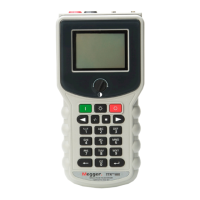M
AVTMTTR100-ENG Rev 6 Nov 2015
18
When testing DC winding resistance, it is important that reliable connections are
made with the transformer being tested. Measuring time will vary depending on
size and vector group of the transformer being tested.
NOTE: The polarity indicated by the TTR100 is relative to the manner in which it
is connected to the device under test.
Single-Phase, Two-Winding Transformers
Perform the following setup procedure for single-phase, two-winding
transformers:
1. Connect the H and X test cables to the respective H and X receptacles of the
test set. Make sure that the connectors are fully engaged into the receptacles.
2. Connect the ground lead of the H test lead set to a low-impedance earth
ground. Connect the clips marked H1 and H2 of the test lead to the
corresponding (high-voltage winding) terminals of the transformer under test.
3. Connect the clips marked X1, X2 of the test lead to the corresponding (low-
voltage winding) terminals of the transformer under test. Keep X3 clear of
ground and test setup. Figures 5-1 and 5-2 show test setups for single-phase
transformers. Figures 5-3 and 5-4 show test setups for regulators. These and
additional connection diagrams are found within the TTR100.
Distribution Transformers with Two Secondary Windings
The TTR100 may test the turn ratios of both distribution transformer secondary
windings simultaneously. Perform the following setup procedure for single-phase
distribution transformer with two secondary windings:
1. Connect the H and X test cables to the respective H and X receptacles of the
test set. Make sure that the connectors are fully engaged into the receptacles.
2. Connect the ground lead of the H test lead set to a low-impedance earth
ground. Connect the clips marked H1 and H2 of the test lead to the
corresponding (high-voltage winding) terminals of the transformer under test.
3. Connect the clips marked X1, X2 and X3 of the test lead to the corresponding
(low-voltage winding) terminals of the transformer under test when testing
both halves of secondary winding (X1 – X2 and X3 – X2).
When testing full secondary winding (X1 – X3), connect X1 lead to X1
terminal, connect X2 lead to X3 terminal (X3 lead is not used in such test, and
it should be kept clear of ground and other terminals). Remove the ground
connection to X2 terminal.

